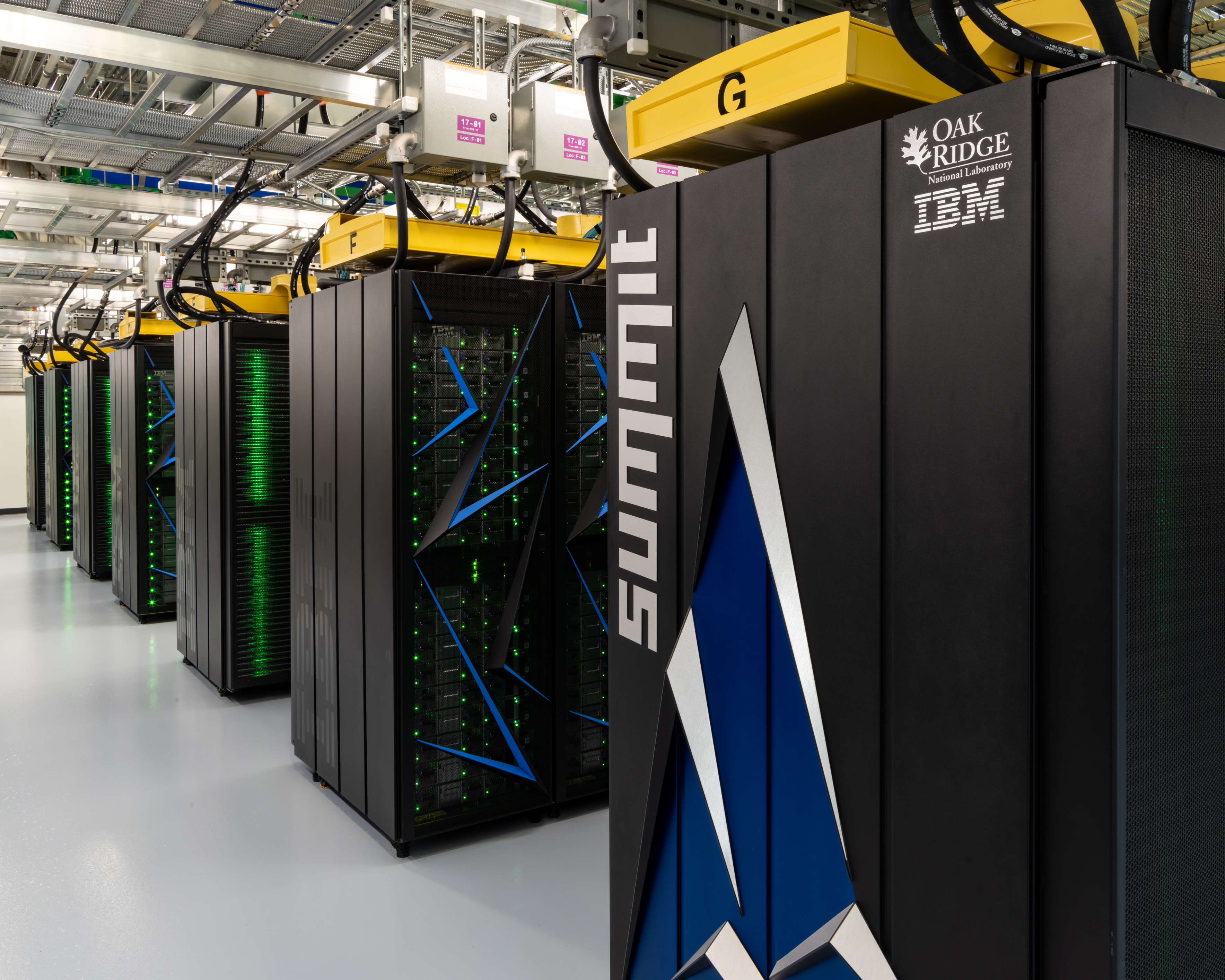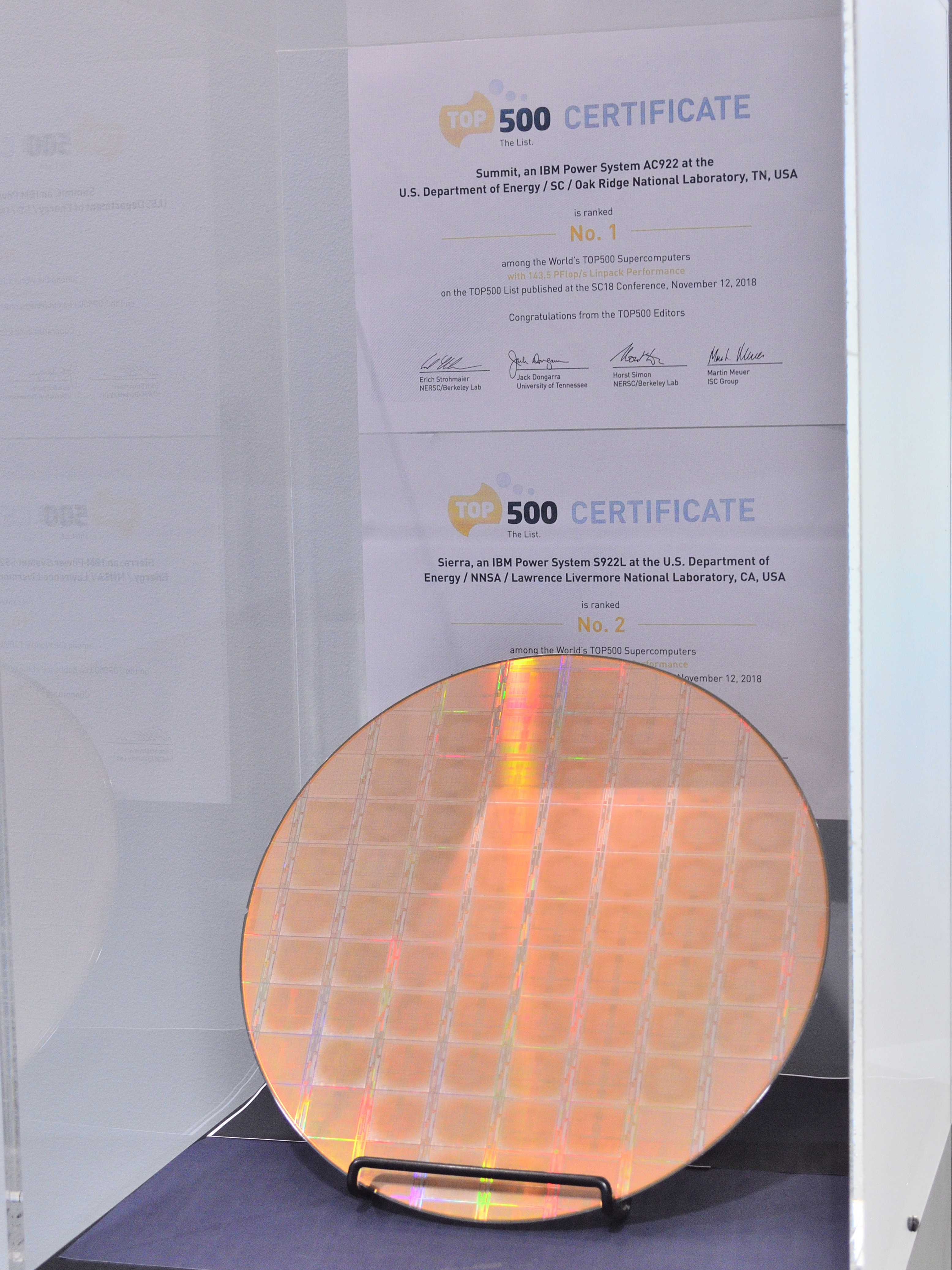Summit (computer) on:
[Wikipedia]
[Google]
[Amazon]

 Summit or OLCF-4 is a
Summit or OLCF-4 is a
A time-lapse video of Summit construction
{{S-end GPGPU supercomputers IBM supercomputers Oak Ridge National Laboratory Petascale computers 64-bit computers

 Summit or OLCF-4 is a
Summit or OLCF-4 is a supercomputer
A supercomputer is a computer with a high level of performance as compared to a general-purpose computer. The performance of a supercomputer is commonly measured in floating-point operations per second ( FLOPS) instead of million instructions ...
developed by IBM for use at Oak Ridge Leadership Computing Facility
The Oak Ridge Leadership Computing Facility (OLCF), formerly the National Leadership Computing Facility, is a designated user facility operated by Oak Ridge National Laboratory and the Department of Energy. It contains several supercomputers, the ...
(OLCF), a facility at the Oak Ridge National Laboratory
Oak Ridge National Laboratory (ORNL) is a U.S. multiprogram science and technology national laboratory sponsored by the U.S. Department of Energy (DOE) and administered, managed, and operated by UT–Battelle as a federally funded research and ...
, capable of 200 petaFLOPS
In computing, floating point operations per second (FLOPS, flops or flop/s) is a measure of computer performance, useful in fields of scientific computations that require floating-point calculations. For such cases, it is a more accurate meas ...
thus making it the 4th fastest supercomputer in the world after Frontier
A frontier is the political and geographical area near or beyond a boundary. A frontier can also be referred to as a "front". The term came from French in the 15th century, with the meaning "borderland"—the region of a country that fronts o ...
(OLCF-5), Fugaku, and LUMI
Lumi may refer to:
Computing
* Lumi (software), chemical analysis software
* Lumi masking, a technique used by video compression software
* LUMI, a supercomputer located in Finland
Music
* ''Lumi'' (album), a 1987 album by Edward Vesala
* ...
. It held the number 1 position from November 2018 to June 2020. Its current LINPACK benchmark is clocked at 148.6 petaFLOPS.
As of November 2019, the supercomputer had ranked as the 5th most energy efficient in the world with a measured power efficiency of 14.668 gigaFLOPS/watt. Summit was the first supercomputer to reach exaflop (a quintillion operations per second) speed, achieving 1.88 exaflops during a genomic
Genomics is an interdisciplinary field of biology focusing on the structure, function, evolution, mapping, and editing of genomes. A genome is an organism's complete set of DNA, including all of its genes as well as its hierarchical, three-dim ...
analysis and is expected to reach 3.3 exaflops using mixed-precision Mixed-precision arithmetic is a form of floating-point arithmetic that uses numbers with varying widths in a single operation.
Arithmetic
A common usage of mixed-precision arithmetic is for operating on inaccurate numbers with a small width and ex ...
calculations.
History
TheUnited States Department of Energy
The United States Department of Energy (DOE) is an executive department of the U.S. federal government that oversees U.S. national energy policy and manages the research and development of nuclear power and nuclear weapons in the United Stat ...
awarded a $325 million contract in November 2014 to IBM, NVIDIA
Nvidia CorporationOfficially written as NVIDIA and stylized in its logo as VIDIA with the lowercase "n" the same height as the uppercase "VIDIA"; formerly stylized as VIDIA with a large italicized lowercase "n" on products from the mid 1990s to ...
and Mellanox
Mellanox Technologies Ltd. ( he, מלאנוקס טכנולוגיות בע"מ) was an Israeli-American multinational supplier of computer networking products based on InfiniBand and Ethernet technology. Mellanox offered adapters, switches, softwa ...
. The effort resulted in construction of Summit and Sierra
Sierra (Spanish for "mountain range" and "saw", from Latin '' serra'') may refer to the following:
Places Mountains and mountain ranges
* Sierra de Juárez, a mountain range in Baja California, Mexico
* Sierra de las Nieves, a mountain range i ...
. Summit is tasked with civilian scientific research and is located at the Oak Ridge National Laboratory in Tennessee. Sierra is designed for nuclear weapons simulations and is located at the Lawrence Livermore National Laboratory
Lawrence Livermore National Laboratory (LLNL) is a federal research facility in Livermore, California, United States. The lab was originally established as the University of California Radiation Laboratory, Livermore Branch in 1952 in response ...
in California. Summit is estimated to cover 873 square meters and require 219 kilometers of cabling. Researchers will utilize Summit for diverse fields such as cosmology
Cosmology () is a branch of physics and metaphysics dealing with the nature of the universe. The term ''cosmology'' was first used in English in 1656 in Thomas Blount (lexicographer), Thomas Blount's ''Glossographia'', and in 1731 taken up in ...
, medicine
Medicine is the science and practice of caring for a patient, managing the diagnosis, prognosis, prevention, treatment, palliation of their injury or disease, and promoting their health. Medicine encompasses a variety of health care pract ...
and climatology
Climatology (from Greek , ''klima'', "place, zone"; and , '' -logia'') or climate science is the scientific study of Earth's climate, typically defined as weather conditions averaged over a period of at least 30 years. This modern field of stud ...
.
In 2015, the project called Collaboration of Oak Ridge, Argonne and Lawrence Livermore (CORAL) included a third supercomputer named Aurora and was planned for installation at Argonne National Laboratory
Argonne National Laboratory is a science and engineering research United States Department of Energy National Labs, national laboratory operated by University of Chicago, UChicago Argonne LLC for the United States Department of Energy. The facil ...
. By 2018, Aurora was re-engineered with completion anticipated in 2021 as an exascale computing
Exascale computing refers to computing systems capable of calculating at least "1018 IEEE 754 Double Precision (64-bit) operations (multiplications and/or additions) per second (exaFLOPS)"; it is a measure of supercomputer performance.
Exascale ...
project along with Frontier
A frontier is the political and geographical area near or beyond a boundary. A frontier can also be referred to as a "front". The term came from French in the 15th century, with the meaning "borderland"—the region of a country that fronts o ...
and El Capitan to be completed shortly thereafter; Aurora is now planned for completion in late 2022.
Uses
The Summit supercomputer provides scientists and researchers the opportunity to solve complex tasks in the fields of energy, artificial intelligence, human health and other research areas. It has been used in Earthquake Simulation, Extreme Weather simulation using AI, Material science, Genomics and in predicting the lifetime of Neutrinos in physics.Design
Each one of its 4,608 nodes (with 2 IBM POWER9CPU
A central processing unit (CPU), also called a central processor, main processor or just processor, is the electronic circuitry that executes instructions comprising a computer program. The CPU performs basic arithmetic, logic, controlling, and ...
s and 6 Nvidia Tesla GPUs in each node) has over 600 GB of coherent memory (96 GB HBM2 plus 512 GB DDR4 SDRAM) which is addressable by all CPUs and GPUs plus 800 GB of non-volatile RAM
Non-volatile random-access memory (NVRAM) is random-access memory that retains data without applied power. This is in contrast to dynamic random-access memory (DRAM) and static random-access memory (SRAM), which both maintain data only for as lo ...
that can be used as a burst buffer or as extended memory. The POWER9 CPUs and Nvidia Volta GPUs are connected using NVIDIA's high speed NVLink. This allows for a heterogeneous computing model. To provide a high rate of data throughput, the nodes will be connected in a non-blocking fat-tree topology using a dual-rail Mellanox EDR InfiniBand interconnect for both storage and inter-process communications traffic which delivers both 200Gbit/s bandwidth between nodes and in-network computing acceleration for communications frameworks such as MPI
MPI or Mpi may refer to:
Science and technology Biology and medicine
* Magnetic particle imaging, an emerging non-invasive tomographic technique
* Myocardial perfusion imaging, a nuclear medicine procedure that illustrates the function of the hear ...
and SHMEM/ PGAS.
See also
*Titan (supercomputer)
Titan or OLCF-3 was a supercomputer built by Cray at Oak Ridge National Laboratory for use in a variety of science projects. Titan was an upgrade of Jaguar, a previous supercomputer at Oak Ridge, that uses graphics processing units (GPUs) in a ...
– OLCF-3
* Frontier (supercomputer)
Hewlett Packard Enterprise Frontier, or OLCF-5, is the world's first exascale supercomputer, hosted at the Oak Ridge Leadership Computing Facility (OLCF) in Tennessee, United States and first operational in 2022. It is based on the Cray EX and i ...
- OLCF-5
* TOP500
The TOP500 project ranks and details the 500 most powerful non-distributed computing, distributed computer systems in the world. The project was started in 1993 and publishes an updated list of the supercomputers twice a year. The first of these ...
* OpenBMC
The OpenBMC project is a Linux Foundation collaborative open-source project whose goal is to produce an open source implementation of the Baseboard Management Controllers (BMC) Firmware Stack. OpenBMC is a Linux distribution for BMCs meant to work ...
* Red Hat Enterprise Linux
Red Hat Enterprise Linux (RHEL) is a commercial open-source Linux distribution developed by Red Hat for the commercial market. Red Hat Enterprise Linux is released in server versions for x86-64, Power ISA, ARM64, and IBM Z and a desktop version ...
References
External links
A time-lapse video of Summit construction
{{S-end GPGPU supercomputers IBM supercomputers Oak Ridge National Laboratory Petascale computers 64-bit computers